Over the weekend, we published a “How to” video explaining how to book a stopover with Air Canada Aeroplan. In comments on the Youtube video and the accompanying post, I came to realize that newcomers to Air Canada Aeroplan might not be familiar with Aeroplan’s unique style of award chart. This post is meant as something of a companion piece for those who were intrigued by the “How to” video, but not sure how to figure out how much an award like that would cost.
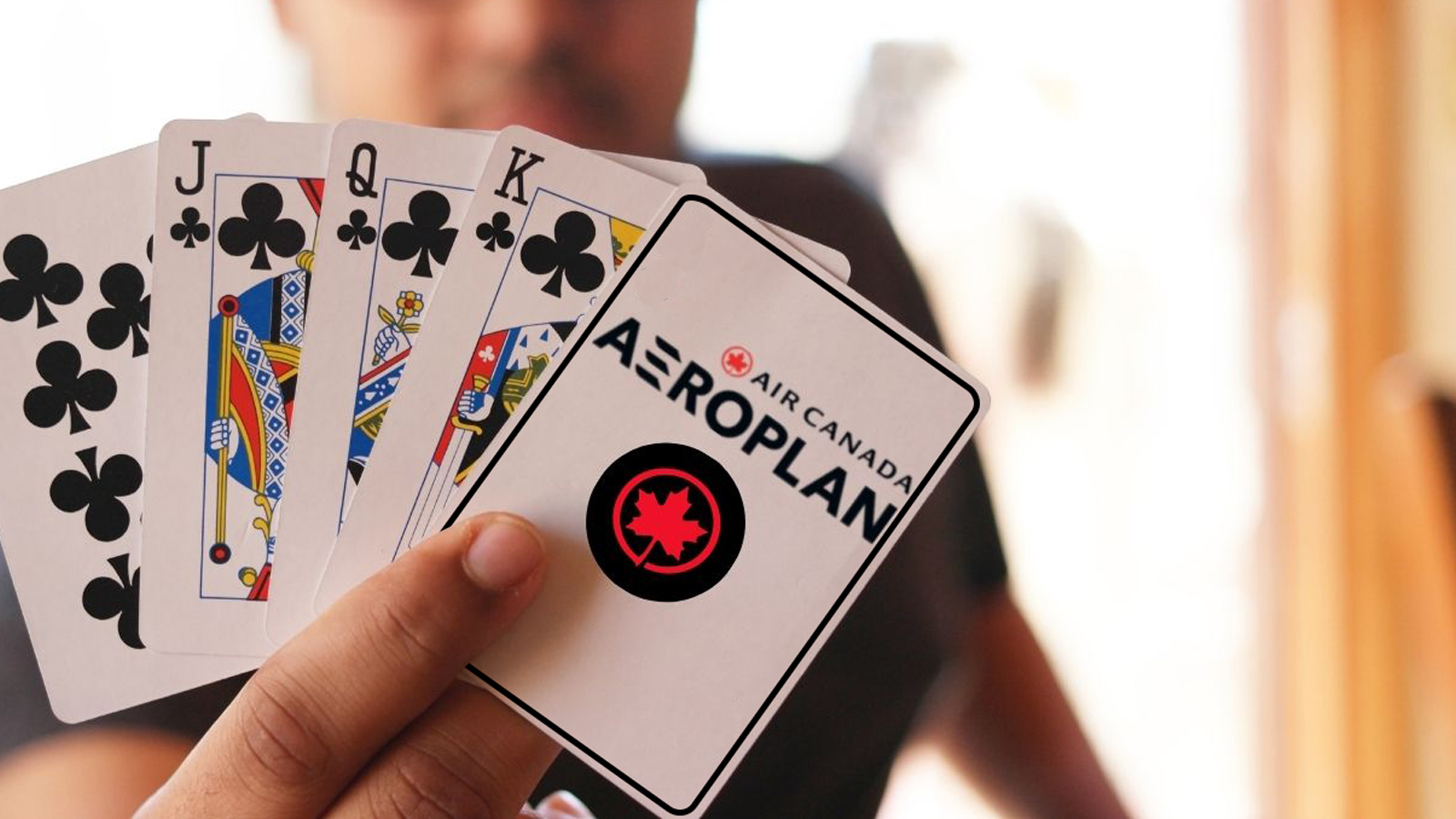
Aeroplan’s nerdy award chart
Air Canada Aeroplan has a super nerdy award chart. See the link below to peruse the entire chart.
Link to the full Air Canada Aeroplan award chart
What I mean by calling the Aeroplan award chart “nerdy” is that their award chart is at once complicated and fun for those who get enthusiastic about booking complicated awards. Aeroplan has both zone-based and distance based pricing.
What that means is that you’ll need to figure out the region of your origin and the region of your destination and then figure out the total distance you’ll travel from origin to destination to figure out the corresponding award price. Additional segments or layovers don’t necessarily cost more miles, but more distance does. You can have one stopover of more than 24 hours in each direction for an additional 5,000 miles, but you could have several long layovers.
When it comes to the number of segments and routing rules, you have a ton of flexibility if you’re looking to piece together something interesting.
Air Canada Aeroplan’s key rules
Air Canada Aeroplan has a few key rules that you need to know:
- You can have up to 6 flight segments in a single direction (but those segments can be on up to 6 different carriers)
- The cumulative distance of your segments can not be more than double the nonstop distance from origin to destination (I’ll explain this in more detail further into the post)
- You can have one stopover on a one-way award for 5,000 additional miles (or one stopover in each direction on a round trip, which costs 5,000 miles per stopover). A stopover is a connection lasting more than 24 hours. A layover is a connection between flights that lasts up to 23 hours and 59 minutes. Note that you could have a layover of 23 hours after every segment if you wanted to (and found aligning award availability). Layovers do not affect the award price (at least not directly; they may increase your total distance flown depending on the routing).
Each of the above will make more sense in context with some examples below.
Air Canada Aeroplan’s award chart zones
Air Canada as split the world into four zones as follows:
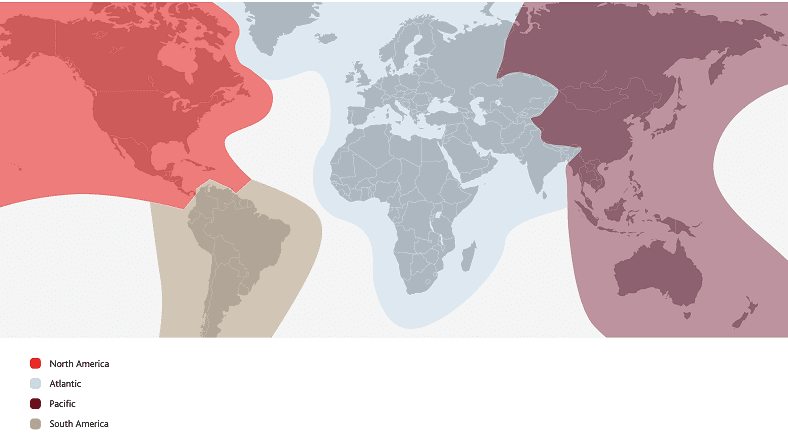
As you can see in the chart, the four zones are:
- North America
- Atlantic
- Pacific
- South America
Again, Aeroplan’s chart is a mixture of zone-based and distance-based elements. First, you determine the zone of departure and destination by simply looking at the map. Then you go to the part of the award chart dedicated to award tickets from your origin zone to your destination zone and see the distance bands. Finally, you’ll measure the distance you’ll fly and determine where that fits into the chart.
In the “How to book Aeroplan stopovers” video, I described a trip from Boston to Bangkok with numerous layovers. In that example, Boston is in the North America zone. Bangkok is in the Pacific Zone. I find awards from North America to the Pacific zone to be among the most interesting options in the Aeroplan award chart because they offer the chance to really stretch the potential value of Aeroplan’s numerous partnerships and award chart rules.
In order to determine the price of an award from Boston to Bangkok, you’ll scroll to the part of the award chart that says “North America to Pacific Zone”.
Aeroplan award chart for travel between North America and Pacific zone (with example)
Once you know your origin and destination, the chart dedicated to that zone combination tells you the award price based on the cumulative distance flown across all of the segments on the award.
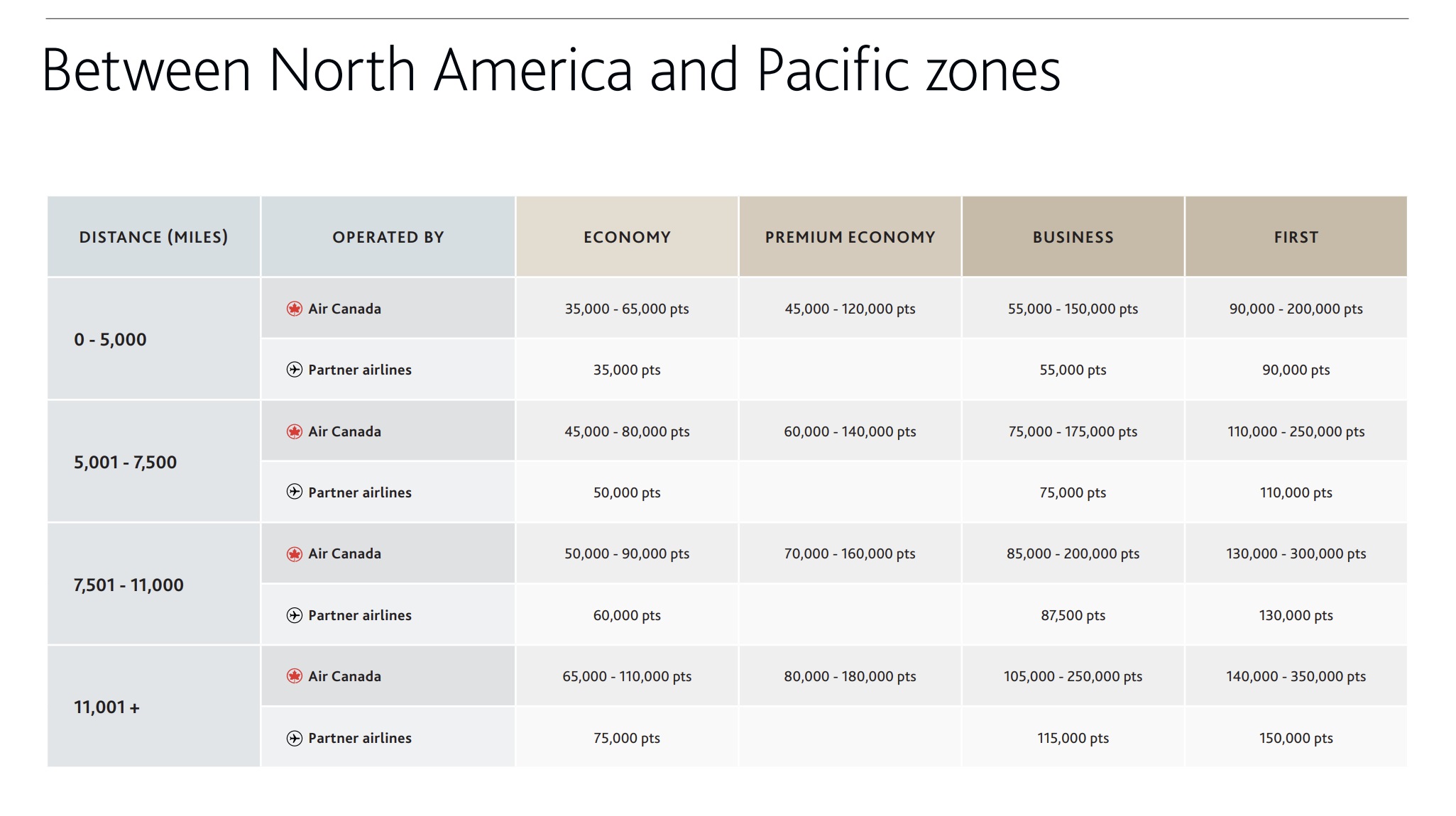
If you look under the Business Class pricing above, you’ll see that an award between North America and the Pacific Zone in business class can range from 55,000 miles to 115,000 miles on Air Canada’s partner airlines (the range extends higher on Air Canada-operated flights since they have more “anytime” type awards on their own metal).
The nonstop distance from Boston to Bangkok is 8,539 miles according to GCMap.com
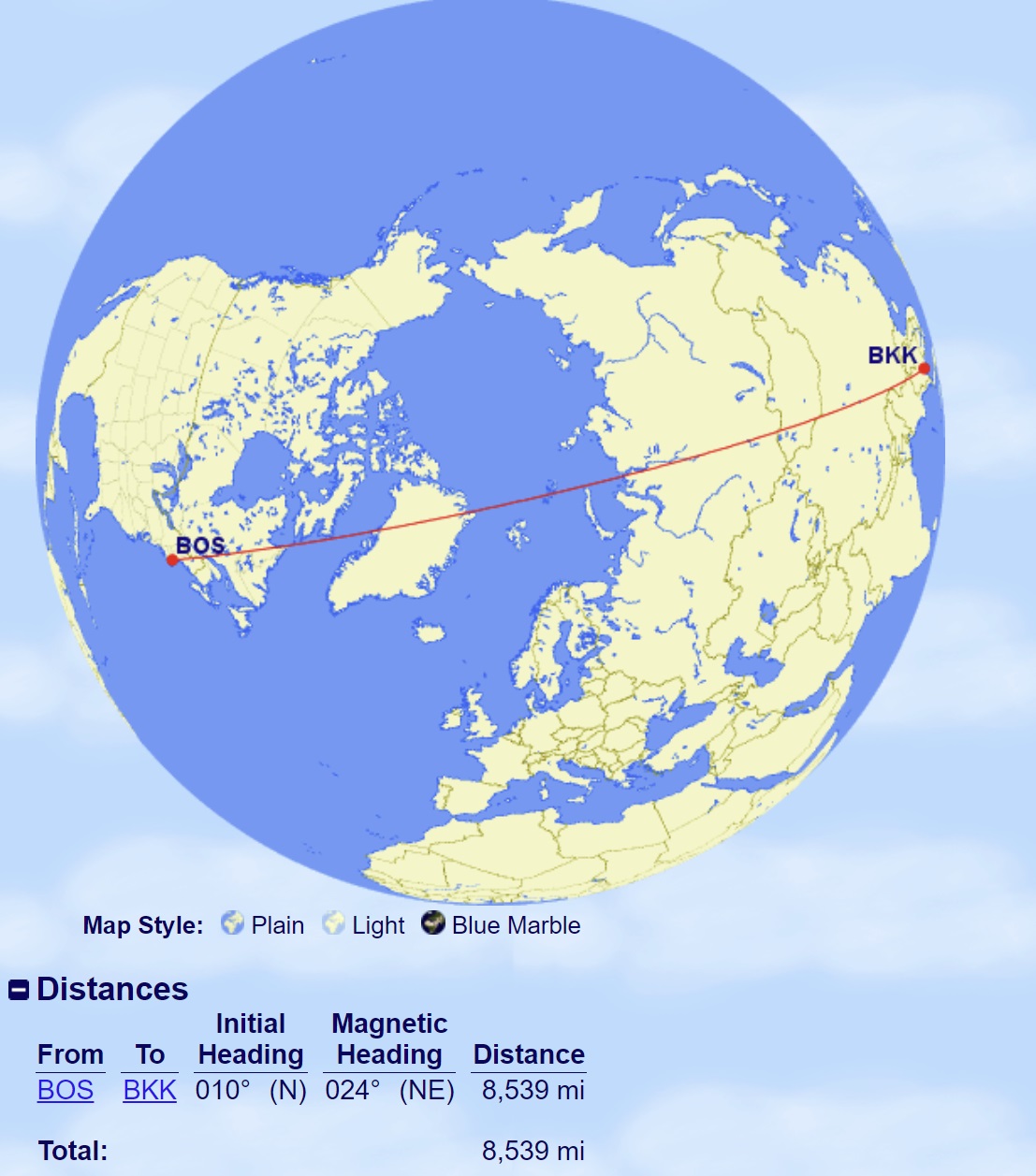
This means that if you want to fly from Boston to Bangkok, the least you’ll pay via Air Canada Aeroplan is 87,500 miles in business class since the distance flown won’t be shorter than the 7,501 to 11,000 miles distance band. If you fly more than 11,000 total miles on your way to Bangkok, the award will cost 115,000 miles. In either case, you’ll need to pay an additional 5,000 miles if you want a stopover.
Which price you pay depends on the cumulative distance of the segments you fly.
For instance, if you fly from Boston to Zurich to Istanbul to Bangkok, you’ll pay 87,500 miles without a stopover or 92,500 miles with a stopover (you could stop over in either Zurich or Istanbul for up to 45 days, but you do need to find award availability for the days when you want to travel). You can only add one stopover on a one-way award, but you could theoretically fly from Boston to Zurich and spend 20 hours (almost a full day) in Zurich before continuing on to Istanbul and then stay in Istanbul for a week and then continue on to Bangkok and it would cost 92,500 miles.
The reason I know this would cost 87,500 miles without a stopover is because a tool like GCMap.com will measure the distances and verify that this would include 9,501 miles flown, which fits in that second-highest distance band in the North America to Pacific Zone award chart.
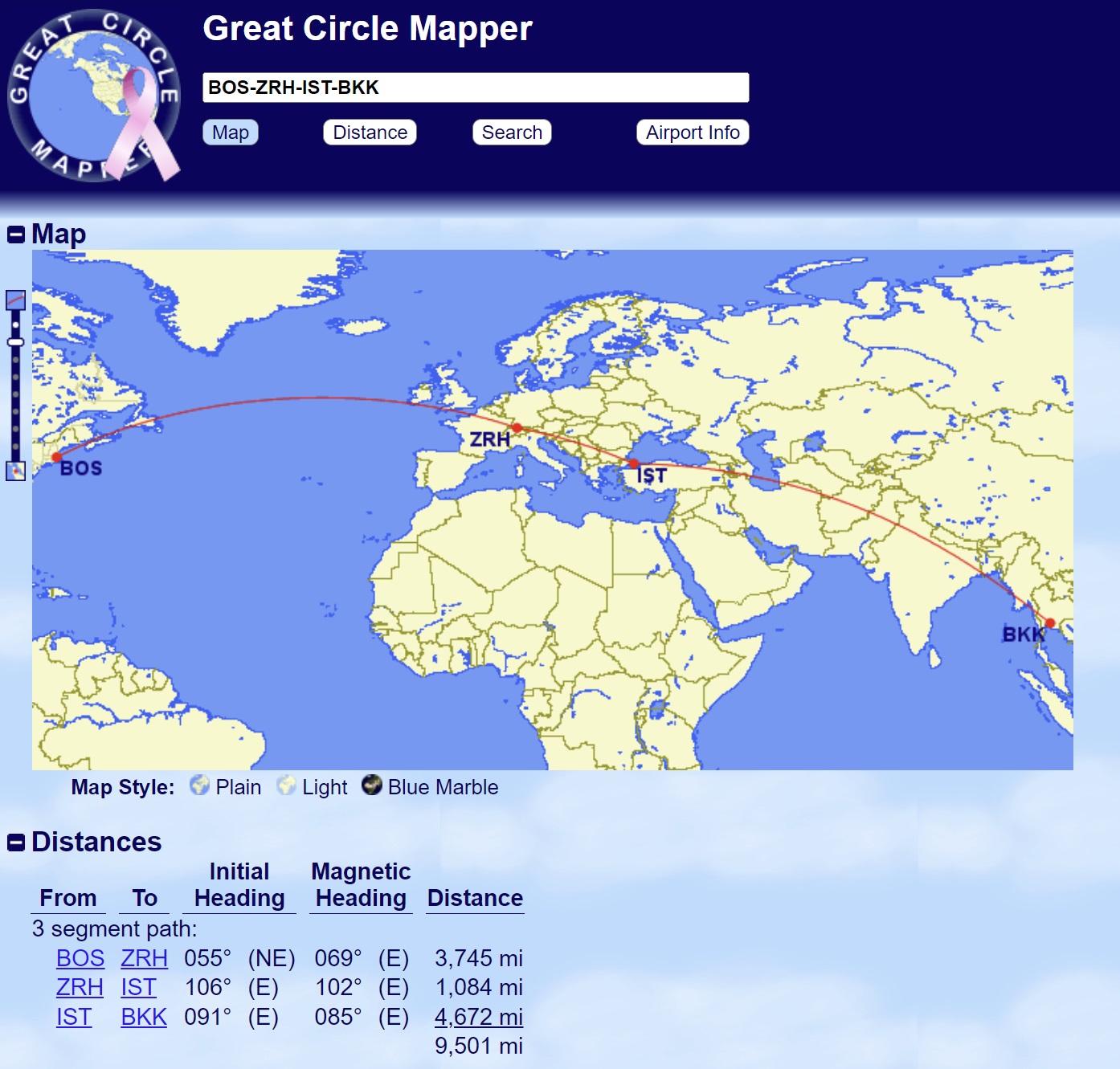
If you want to fly out of your way a bit and visit a few places, you could fly something like Boston to Zurich to Istanbul to Muscat to Kuala Lumpur to Tokyo to Bangkok.
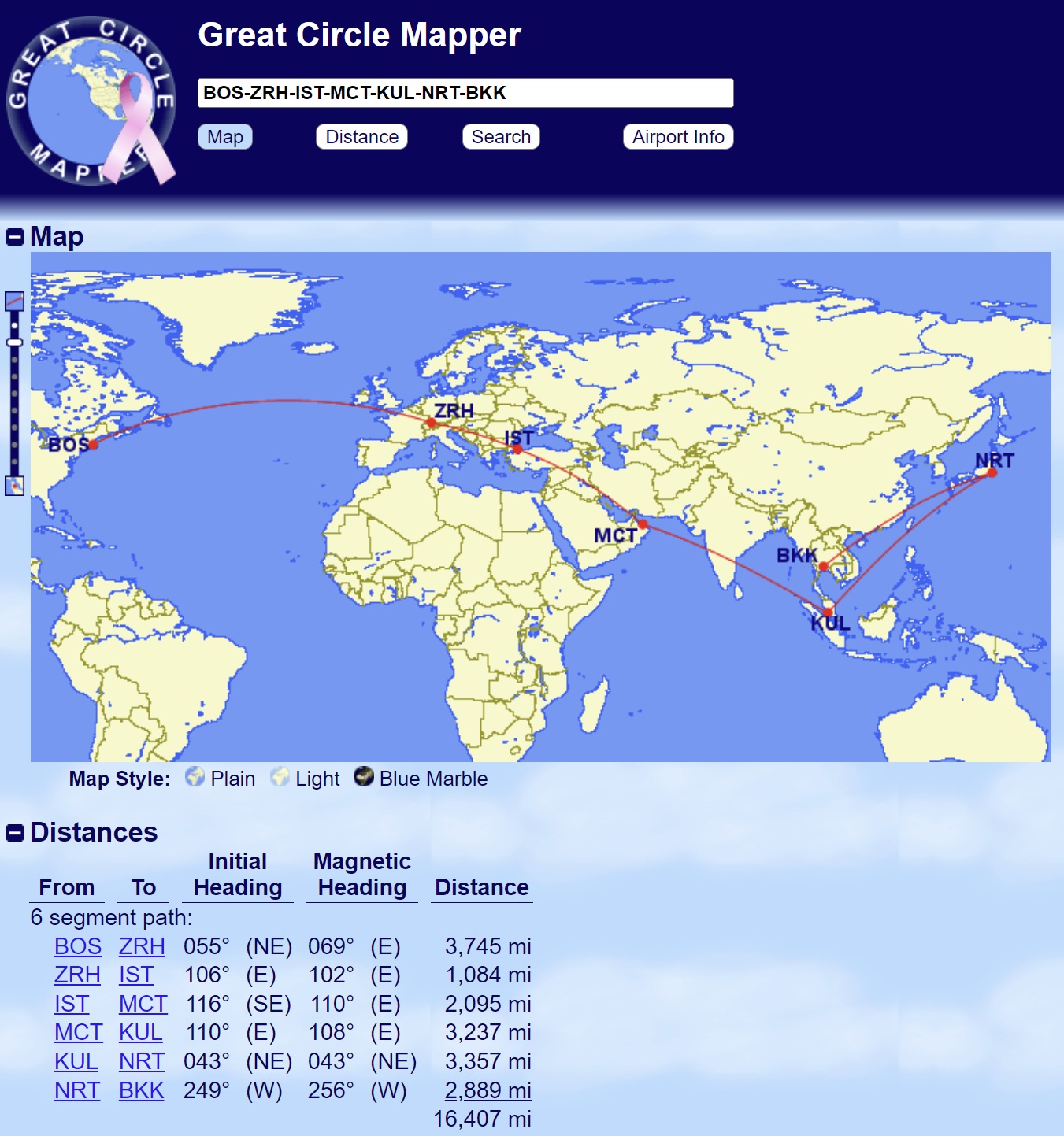
Tokyo obviously isn’t “on the way” to Bangkok in this case, but that doesn’t matter. What determines the award price is total distance flown.
As you can see, that award would cover more than 16,000 total miles flown, so you’ll pay the price for a North America to Pacific zone itinerary of 11,001+ miles flown, which costs 115,000 miles in business class without a stopover or 120,000 miles with a stopover. The price is the same whether you stop over in Zurich or Istanbul or Muscat or Kuala Lumpur or Tokyo. The price is also the same whether you have a 2 hour layover in each of the non-stopover cities along the way or a 23 hour layover in each of them.
If you plan a long layover that lasts over night, you will of course be on your own for the cost of transportation from the airport into the city and the cost of a hotel. Obviously that may or may not interest you depending on the situation (place / time / your own interests / etc). Personally, I’m perfectly happy to get an Uber or Taxi and use my points to stay at a hotel to explore a city for a day. I think it also helps with time zone transitions to break things up with a night in a comfortable hotel along the way.
You’ll also obviously need to look into any visa considerations depending on where you’re going. But the bottom line is that this is doable.
Circuitous routings are OK
The routing I showed above from Boston to Bangkok is not particularly direct and it includes some “backtracking” from Tokyo to Bangkok. That’s OK with Air Canada Aeroplan — up to a limit.
Aeroplan’s core routing rule is that the total distance flown can not be more than double the nonstop distance from origin to destination.
In other words, you can see above that the nonstop distance from Boston to Bangkok is 8,539 miles. Your routing therefore could be up to 17,078 miles flown (this is approximate since the GCMap tool may not exactly match Aeroplan’s computer system). The routing above with the out-of-the-way flight to Tokyo should be totally fine. This makes for fun opportunities if you want to visit a couple of places. You could at least theoretically plan for longer segments to occur overnight and treat the plane like a hotel room to rest and then get up and explore a new place.
I also find the flexible routing rules exciting because of Aeroplan’s numerous partner airlines. You really have a lot of opportunities to be creative thanks to the breadth of Aeroplan partnerships.
How do you find award availability?
The final question to get you started in planning your own trips is, “How do you find award availability?”. This part is relatively easy to try to do (being successful of course depends on some luck).
You’ll simply search each segment at AirCanada.com looking for award availability. Find available flights and write down the flight numbers, then call Aeroplan to book over the phone. Note that hold times can be atrocious — it isn’t entirely uncommon to wait 2 hours to speak with someone. The good news is that you can usually leave your phone number to get a call back when an agent is available.
The biggest challenge for some folks is that certain segments may show up when joined with another segment but not show up individually. In the first example I gave above, you may find Turkish Airlines to only have long-haul availability if you search from Zurich to Bangkok but not if you search from Istanbul to Bangkok. I’ve had success in explaining to an agent that they need to search that part of my itinerary from Zurich to Bangkok rather than from Zurich to Istanbul.
The rest is just searching. For instance, I could start out with Boston to Zurich and find a nonstop on SWISS:
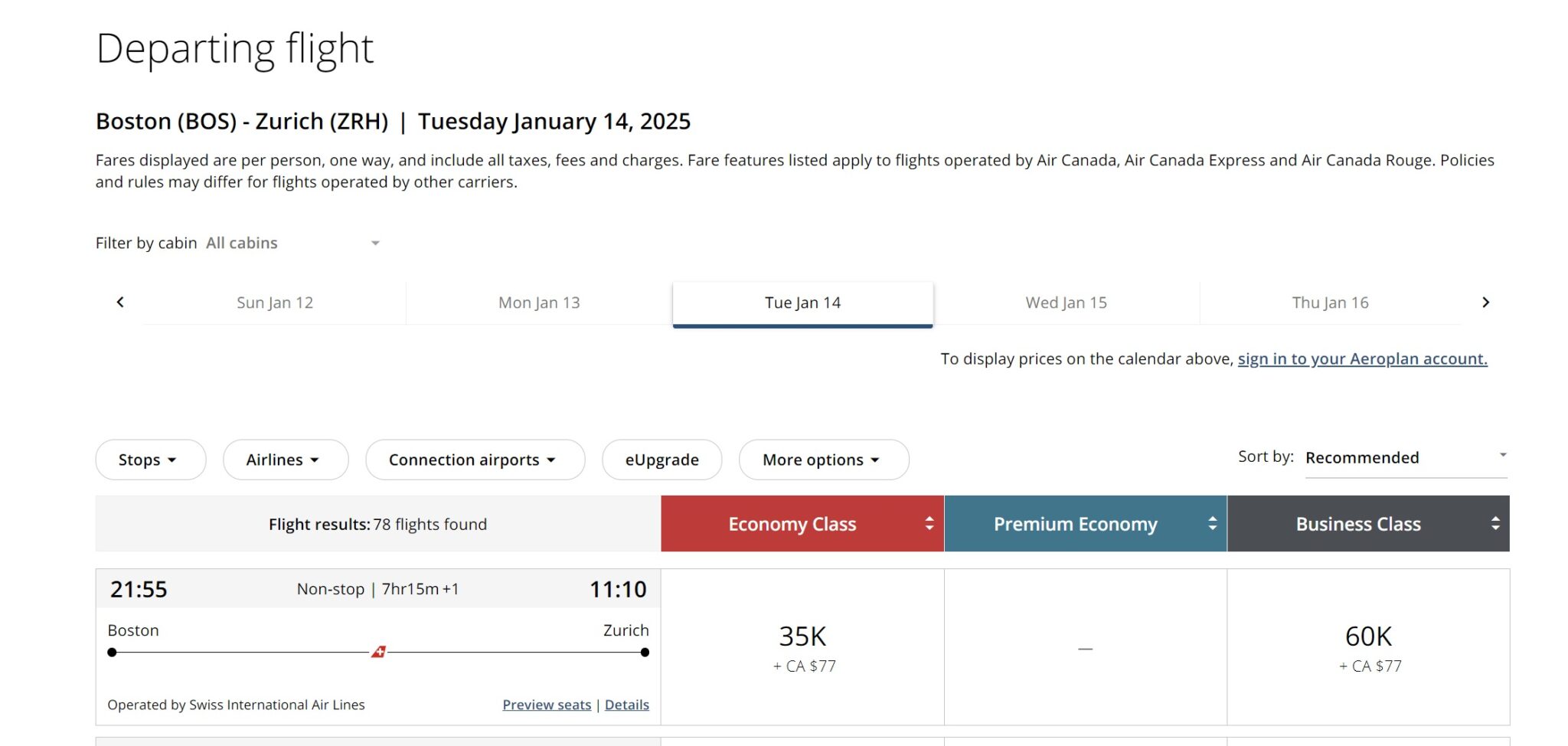
That flight departs on January 14th at 21:55 and arrives on January 15th at 11:10am. The next segment from Zurich to Istanbul therefore must depart before January 16th at 11:10am if I don’t want to pay for a stopover in Zurich. Luckily, you can stick the landing on that with an 11:05am departure from Zurich to Istanbul on January 16th (the second result here:
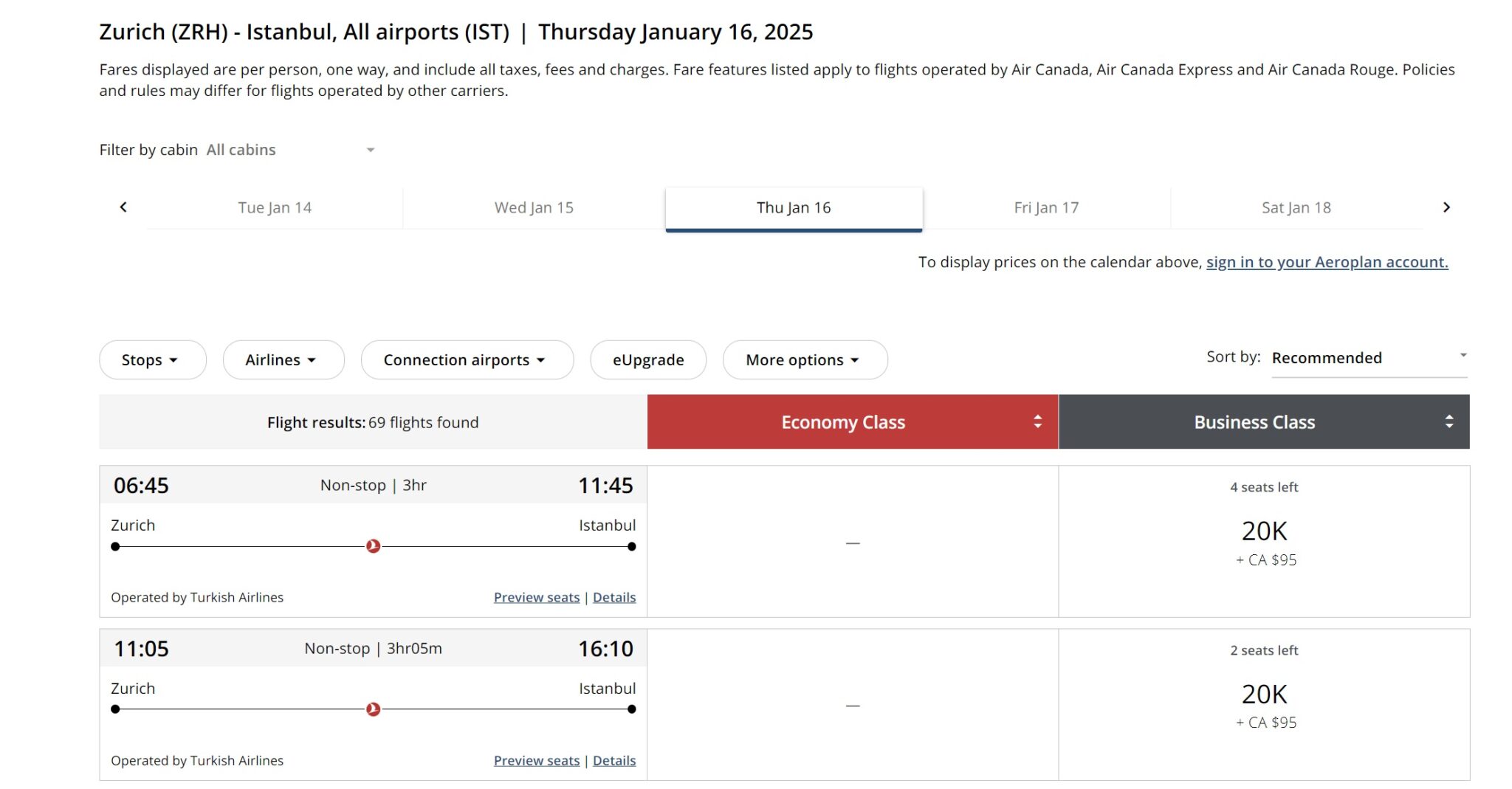
Again, that would mean this:
- January 14: Fly Boston to Zurich, departing at 21:55 and arriving at 11:10am on January 15
- January 15-16: Spend 23 hours and 55 minute in Zurich
- January 16: Fly Zurich to Istanbul, departing at 11:05am and arriving at 16:10
Then having arrived in Istanbul at 16:10 on January 16th, you could continue on from Istanbul to Muscat on the 01:20 departure on January 17th, having had about 9 hours to enjoy the fabulous Turkish Airlines business class lounge in Istanbul.
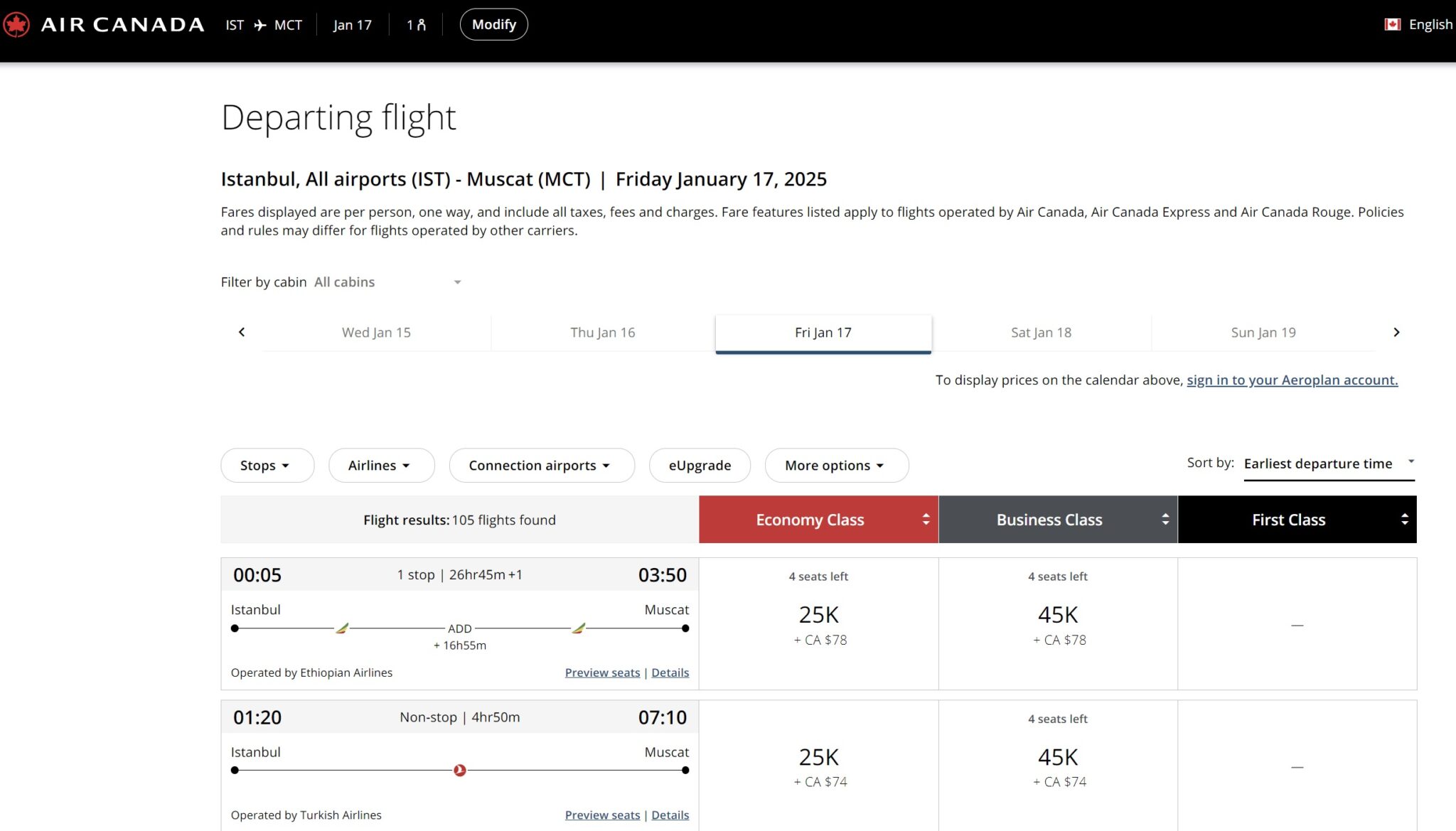 From there, perhaps you use a stopover of more than 24 hours to stay in Muscat for a few days and so on. That’s the process for searching for award space.
From there, perhaps you use a stopover of more than 24 hours to stay in Muscat for a few days and so on. That’s the process for searching for award space.
When I settle on segments I like, I simply hit “Details” (under the flight arrival time in the screen shots above) and I write down the flight information for each segment I want, including city pair, date, and specific flight numbers so I can feed that information to a phone agent.
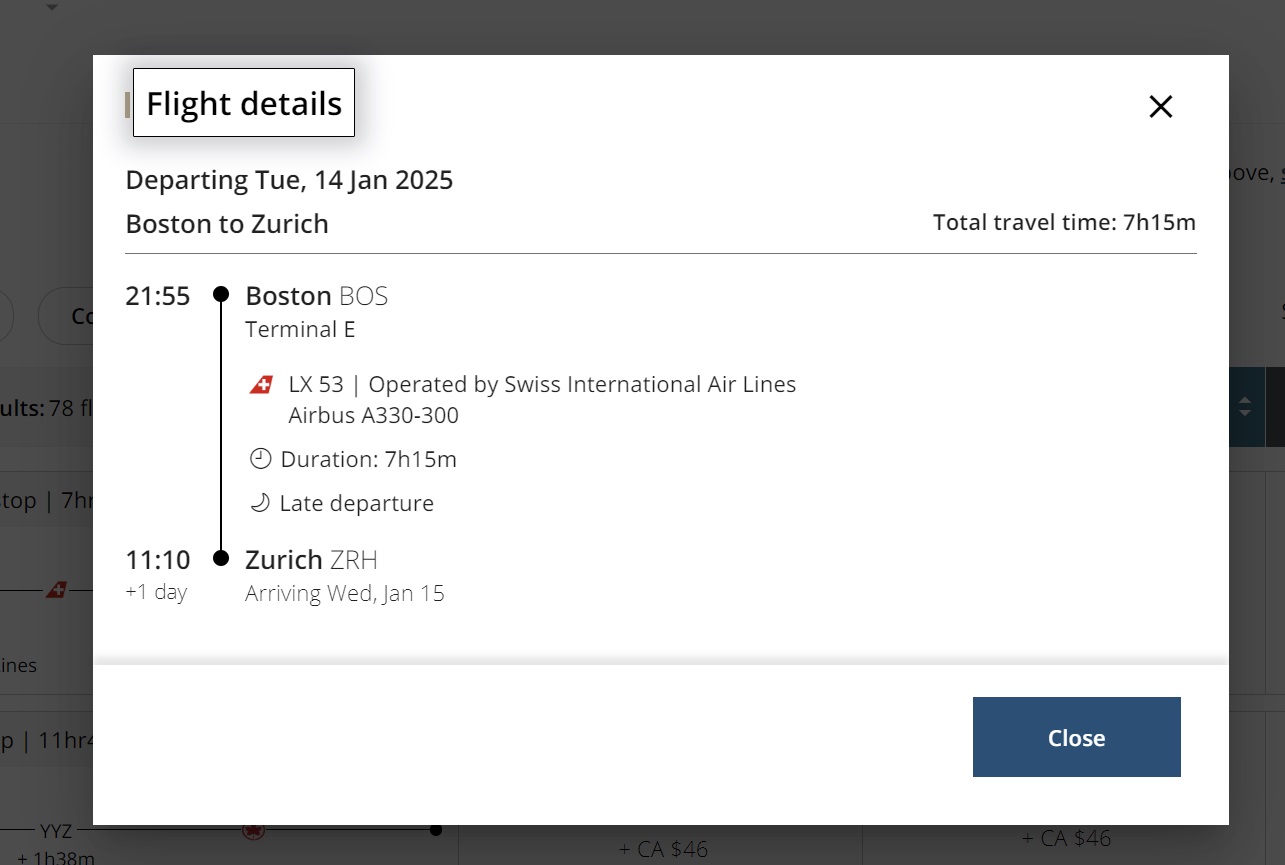
Then, when I call Aeroplan, I simply provide the agent with the dates, city pairs, and flight numbers I want for the entire itinerary. They go to check availability and price it and most of the time the process goes smoothly from there.
However, I strongly recommend calling to price out your chosen itinerary before transferring miles. In the example I’ve given here, I don’t know for sure whether SWISS is showing phantom availability. I’d recommend calling and agent and letting them build out and price the itinerary, then you can transfer to book while on the phone.
Bottom line
Air Canada Aeroplan has a wonderfully nerdy award chart. I very much enjoy imagining the possibilities. Based on questions we got about our recent How to book an Aeroplan stopover video, it was clear to me that it isn’t necessarily intuitive to determine how many miles a particular itinerary will require. However, once you get the hang of it, it’s easy to search awards at AirCanada.com and use a tool like GCMap to calculate distances so that you can know the award price before you even get on the phone. This type of thing obviously (and reasonably) won’t appeal to everyone, but for those who enjoy nerding out on this stuff, the Aeroplan award chart can fill many hours of daydreaming.



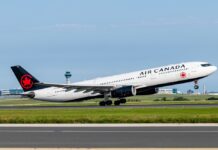

Can you start at an airport then pass through it again on the way back? For example, ATH-HER-ATH-FRA with a stop in Heraklion then connecting in Athens on the way to Frankfurt.
I booked Kuala Lumpur to Atlanta with 5 day stopover in Dubai, for 120k in business class. KL to Singapore and then to Dubai both flights on an A350, then flying Turkish Business stopping in Istanbul then to ATL.
Might be obvious for some but this is entirely based on partner awards. If there is even one Air Canada segment, the chart goes out the window and there has to be a published fare for the routing you want to take
This seems like it should be written in fire across the sky.
I just spent many hours trying to stitch together an Aeroplan award routing with a stopover, following all the details provided in the post and in the video. Complete and utter failure.
I spent many hours at this. I found available space for each and every individual leg (wasn’t easy, I looked at hundreds of possibilities), double-checked and noted every detail. Called in and found a friendly, willing Aeroplan agent, to whom I fed all the details. She entered them into her system and then the “hmmmm” started. Hmmm, ummm, hmmmm…” It wasn’t working for her. I double checked every detail of every single leg, and re-read each back to the agent to confirm she got them right. No joy. She went off to confer with a senior supervisor and was gone conferring for over 20 minutes. She came back and said they could not get their system to accept it or price it.
This itin was a total of just 4 legs. Starting in IST ending in SEA, with a stopover in NRT. I explained carefully that this was a one-way award booking with a STOPOVER (at NRT). Overall the origin was IST, destination was SEA, stopover in NRT. Initial flights were IST-CAI-NRT, then the stopover in NRT, then onward NRT-YVR-SEA. According to gcmap.com, the straight-line distance for IST-SEA is 6071 miles. For all the legs I was trying to stitch together, the cumulative distance is 11,557. Since twice the direct, straight-line distance between IST and SEA is 12,142 (2 x 6071), my stitched-together route should qualify, according to what’s alleged in the post and video. Aeroplan staff were trying to be helpful but were perplexed.
Two legs of the itin were on Air Canada metal (NRT-YVR and YVR-SEA). Oooooooooooooooooh…does that matter? Seems like that would have been a useful fact to include. You know, when booking with AIR CANADA’S PROGRAM.
If farnorthtrader is correct, then all the work I put into this, and all the work the Aeroplan agent and their Senior Supervisor put into this (and all the work that who-knows-how-many others did) was wasted. Ooops.
The agent apologized and said their system rejected the itinerary and would not accept it. They threw out my itin and since they figured I was just trying to get from IST to SEA, they pieced together an itinerary from NRT-SIN-FRA-YVR-SEA and their system accepted that. The cost they said, would be 267K to 350K points + CA$360 per person for that. That’s just from Tokyo to Seattle, mind you – never mind getting the other half of the itinerary (from IST to NRT).
I’m impressed by the people who can get adequate rest on an overnight flight so much so as to treat it as a hotel night and then have the energy/focus to sight see for 18 hours before repeating the airplane hotel again. I’m lucky to get 4 hours of sleep on an overnight, with a guaranteed jetlag hangover for at least a few days. I like the idea of the longer stopover for 5k though every time I try for when I can go, I rarely find award segments I want.
I aim to impress 🙂
Lol. Well said.
Very clearly explained, and so interesting! Thank you!
If that 11:05 departure from Zurich gets delayed and pushes you over 24 hours, they can’t retroactively charge a stopover 5000, right? I assume no, but hertz arrests people, so……
So this exact scenario actually happened to me. They didn’t charge the 5000 miles after the fact, at least not yet (it’s been a couple months). Technically my trip violates the rules because now I have two stopovers, but I think as long as you don’t need to reticket the itinerary the system doesn’t care.
No, that’s fine if it happens